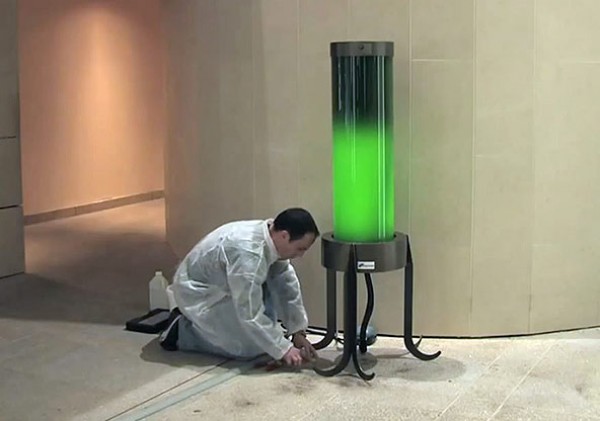Editor’s Note: This story, based upon information we’ve been seeing, holds some viability questions as to whether or not the lamps are powered by energy from photosynthesis, or simply C02 scrubbers. As such, we’ve positioned it more as a C02 scrubber, with thoughts on what it might take to evolve into an actual self-powered device.
Algae are a large, diverse group of simple microorganisms that have lived on Earth for billions of years. Although we typically associate the term algae with the slimy green stuff that accumulates on the surface of a stagnant pond, seaweed and kelp are also member of the algae family. In the right situations, algae can be very useful to humans, and their potential as an energy source has received lots of attention over the past few years.
French biochemist Pierre Calleja is now looking at algae as a potential source for helping clean the air of carbon dioxide. He has spent several years developing what looks to be an interesting street lamp that feeds on the vast amount of C02 swirling around in our atmosphere.

The lamps are really more like massive tanks filled with water and algae. As you can see from the video below, the lamps, making use of a lighted environment, work with the added micro-algae to scrub out the C02 in the air. What’s not exactly clear is how this process works. There are certainly examples out there of micro-algae being bred specifically to absorb carbon emissions (you can even try building this one if you have the DIY skills), but whether that includes this pet project of Calleja is unknown. Perhaps it involves a carbon sink making use of photosynthesis?
Now one thing there’s been some confusion on out there, and which this story originally got hung up on, is whether or not this could also be a self-powered lamp. In a lighted environment, the process that results could perhaps create energy, like a similar idea we wrote about back in 2010 that is inspired by a technique developed by scientists from Yonsei and Stanford University, that might possibly be stored in batteries connected to the tank. The stored energy could perhaps then be used to power the lights at night, though questions have been raised by some, such as at The Atlantic, on how viable this solution might really be.
There’s no denying that the street lights are cool, and if they became a regular fixture in densely populated cities – and are actually viable – they could have a massive impact air pollution in urban areas where trees are scarce.